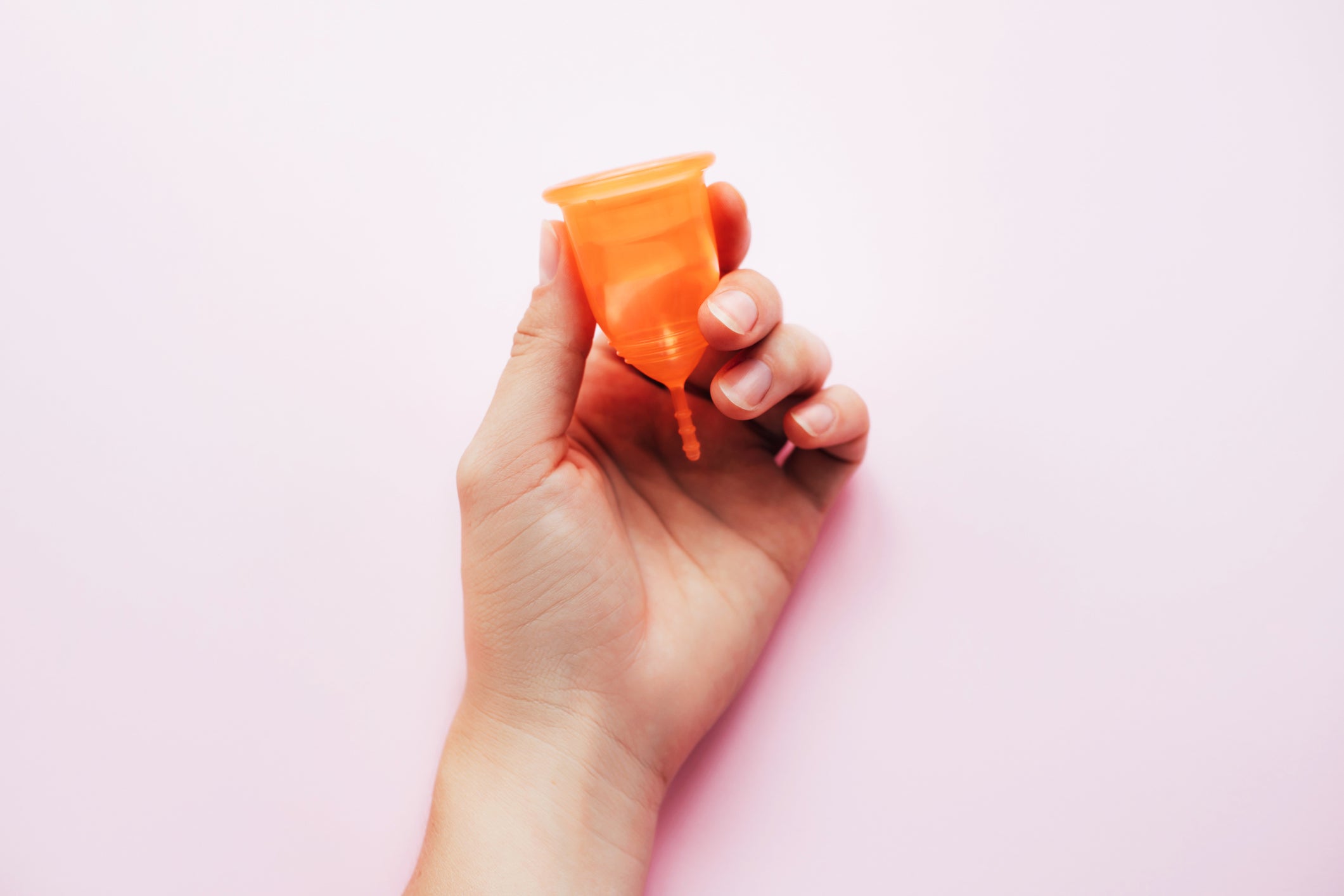I changed up my sanitary products for a more sustainable menstrual cup. This is how I got on
Banana bread, Duo Lingo and pottery all took a backseat in lockdown to finally getting a handle on an alternative and more eco-friendly period product for Helen Coffey


Forget baking bread, learning a language or creating a minute-long one-woman skit worthy of Tiktok – my lockdown 3.0 self-improvement kick wasn’t going to be half so cheery, nor so appetising.
No, my chosen “hobby”, if you can call it that, while stuck indoors throughout the endless winter, was to finally get to grips with using a menstrual cup. It was the perfect setting: I wasn’t going to get “caught out” anywhere new, wondering whether to change the thing in a public toilet. I wasn’t going to have a mishap at work and have to cover my Hammer horror-esque groin with a sweatshirt all day. Here it was, a blank slate of time in which to master this darkest of female arts. I was scared. I was excited.
There are all kinds of good reasons for switching to a cup, not least of all the financial incentive: it saves, on average, £4,900 over the course of a life’s-worth of ovulation and menstruation, according to a 2019 study by menstrual cup brand Intimina. It means you’ll never get caught out without a tampon or pad, forced to corner colleagues in the office loos and beg for spares. But, crucially, the environmental impact is huge.
For all that many of us may have proudly swapped to Keep Cups for our coffee and reusable metal straws for our G&Ts, few of us ever contemplate the amount of single use plastic that’s in our sanitary products. Think about it: tampons are wrapped in plastic with plastic applicators, pads come with a plastic leak-proof base and often use synthetic fibres in the absorbent part as well. When you consider that every menstruator will use between 5,000 and 15,000 sanitary products in their lifetime - most of which will end up in landfill as plastic waste - it’s an uncomfortable and sobering thought.
This was reason enough to make the switch – but there was one other, more secret reason I was determined to try. Truly, I wanted to do it to prove to my inner feminist that I could get up close and personal with my own vagina; and that I wasn’t grossed out by my own periods.
Our entire lives, we’re implicitly told that our monthly cycle is disgusting. Something to feel shame and embarrassment about. It’s there in all the advertising – blood is represented by a blue liquid. We rarely see any hint of an actual period, because that would be beyond the pale. As recently as 1 January, a tweet complaining that a drawing of a tampon – not even a real tampon – was “obscene” went viral.
Even the products themselves have distance built in so that you can disassociate with what’s going on down below. Applicator tampons aren’t just popular because they’re easy to use – it’s because they allow us to keep ourselves at one remove from all that…unpleasantness. You barely have to touch yourself, let alone come into contact with your womb lining. You can almost pretend it’s not happening at all.
Applicator tampons aren’t just popular because they’re easy to use – it’s because they allow us to keep ourselves at one remove from all that…unpleasantness
Not so with a cup. You have no choice but to get stuck in (“stuck” occasionally being the operative word). Considering I was a first-time cuppee, I didn’t do a whole lot of research before buying. Or any, come to think of it. While it had been in the back of my mind for a while, the purchase itself was done on a whim – a spur of the moment decision while glumly looking at the pricy boxes of tampons lined up in my local supermarket. Next to them was a “Hey Girls” cup. It looked fun, it looked friendly! Most of all it looked cheap by comparison – £9.48 for a reusable product that claimed to be in it for the long-haul (up to 10 years). Upon closer inspection, it turned out the brand was also committed to tackling period poverty, with a “Buy One, Give One” philosophy that means for every product bought they would give one away. It was the extra resolve-hardener I needed to take the plunge.
For those on the outskirts of the menstrual cup world, the only brand you’re likely to have come across is Moon Cup. Indeed, I was taken aback to find that the market has really blown up since it was reserved for a certain kind of earth-mother-type with dreadlocks and vegan leather shoes. Moon Cup – and those pioneering, prescient women – may have paved the way, but in their wake have sprung up a multitude of choices: OrganiCup, Saalt, Eden, Lunette, BeYou, Intimina, Nudie, Nomai, Ruby Cup, Diva, Eva… the list is seemingly endless. In a way, I’m glad I had no idea of the vast selection available when I bought one. I would have been paralysed by choice.
By all means do your homework if you’re tempted to make the switch, but I don’t advise getting too hung up on it – they all have broadly the same make up, forged from medical grade silicone and shaped, well, like a cup, with a little handle on the end for easier removal. Just ensure you get the right size (there are generally only two – small ones for youngsters who haven’t given birth, bigger ones for everyone else) and take it from there.
Not to get too graphic, but using a cup made me realise just how little I’d really known about my anatomy. Using applicator tampons for nearly 20 years meant I’d never really got up in there, as it were, and so the first time trialling the cup was daunting. But I kept at it, chipping away at my own ignorance, and each time it got a little easier – the folding, the insertion, the twisting and positioning, the feeling to check the placement was correct.

I was glad I’d started the whole business from home, because to start with I was pretty slow – and wouldn’t have appreciated the added time pressure of a slowly growing queue outside a public ladies’ toilet – plus I had a couple of minor leaks when I hadn’t figured out how to put it in right. But by the end of my first cycle, boom! Just like that, it clicked into place. And I was left with one overriding question: how did it take me this long to try it?
The cup was so comfortable I forgot it was there even when exercising, I could go for the best part of a day without emptying it, there was no smell, no leaks, no nothing. Best of all, I felt so much more comfortable with my bits and rooting around in them; I finally stopped feeling disconnected to – and weirded out by – my body and its excretions; I finally broke free of a lifetime’s indoctrination.
The tampon is dead: long live the cup!
Tips for beginners
Make sure the cup is wet
I did not know this on my first go. It’s common sense really, that trying to put a substantial piece of bone dry silicone up there… well, it’s not that pleasant. Make sure you wet it from the tap first, or you can use lube if preferred.
Reposition it as much as you need to
You can’t just shove a cup in and hope for the best – if it’s going to feel comfortable with no leakage, it has to be in the correct spot. If you can feel it’s still folded or scrunched up once inside, it ain’t going to be a goer. Sometimes it goes right first time, other days it just isn’t working and takes a few tries. It always works out in the end though – just be patient, stay calm, and take it out and try again as many times as you need to.
If you need to wee a lot, it’s not in the right place
If it’s not in the right position, the cup can press on your bladder and make it feel like you constantly need the loo (I write this from experience). It might need to go higher up or lower down depending on your anatomy – experiment and find your ideal positioning.
It will always come out
It’s hard not to worry at first that the cup won’t get stuck in there. It goes fairly far into your vagina and forms a seal – which means that, if positioned correctly, it doesn’t leak. Huzzah! This also means it can feel like it’s not going to come out – but, trust me, it always does. One trick I’ve stumbled across is to use toilet paper to help you gain better purchase on the handle when pulling – it works on the same principles as using a dry dishtowel to get a grip when opening a jam jar. Always breathe deeply and keep calm too, as tensing up obviously doesn’t help matters down below.
Remove your cup over a toilet
You would probably do this anyway, because you’re not an idiot. I did not do this one time and it just so happened to be the time I managed to pull too hard, too quickly, and my hand jerked and… let’s just say it will forever be known as my “Carrie moment”.
Join our commenting forum
Join thought-provoking conversations, follow other Independent readers and see their replies
Comments
Bookmark popover
Removed from bookmarks